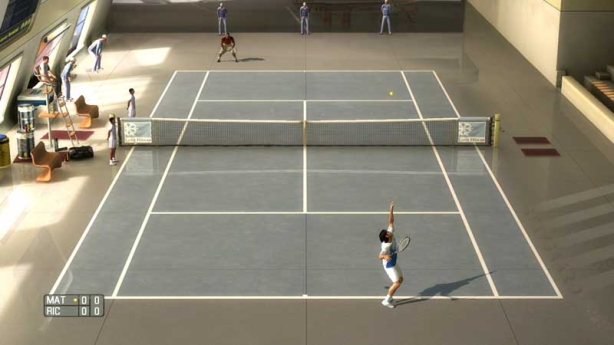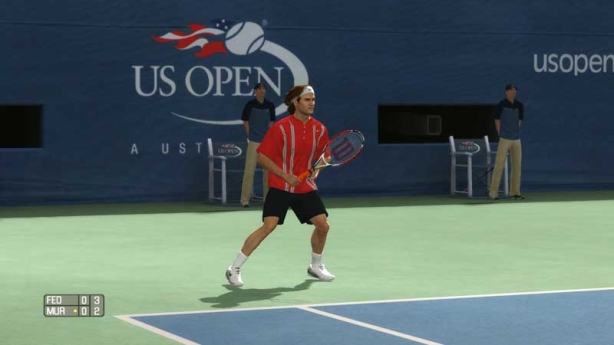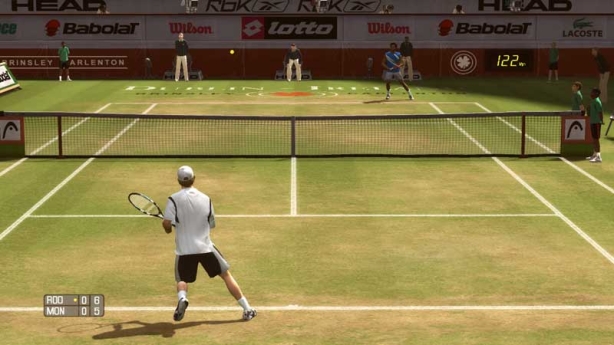Top Spin 4 Review
Developer: 2K Czech
Publisher: 2K Sports
Available on: Xbox 360 and PlayStation 3 (Xbox 360 version reviewed)
Top Spin 4 is the fourth in 2K Sports’ Top Spin series of tennis games (we like to state the obvious here at GodisaGeek), and it is impossible to review it without making mention of the fact that a flashier rival, SEGA’s Virtua Tennis 4, is due out in May. Consequently, Top Spin 4 will have just two months to prove its credentials before Virtua Tennis 4 steps on to the court.
Although in an ideal world games would be judged purely on their own merits, real-life gamers need to consider how best to spend their hard earned cash. So before embarking on an in-depth review of Top Spin 4, it is worth citing the most significant difference between the two games at this stage. That is, whilst Virtua Tennis 4 can be controlled using Kinect as well as the Wii and PlayStation Move, Top Spin 4 does not support the Xbox 360’s motion control system. So although PlayStation 3 and Wii owners will have the luxury of taking a more subjective approach to their choice of game, the decision of Xbox 360 tennis fans will no doubt be influenced by Top Spin 4’s lack of support for Kinect.
So without further ado (there has been quite some ado, I grant you), let us explore Top Spin 4. As a game with a focus on timing and subtlety over arcade-style fireworks, it may well win fans amongst those who are looking for a more realistic tennis experience that make up for those lost due to its lack of Kinect support. For those of you twiddling your Wiimotes and Movedildos, there should hopefully be enough information about the ancillary features to help you decide whether Top Spin 4 is the tennis simulator for you.
STORY: None to speak of. Although Top Spin 4’s centrepiece is a Career Mode in which you create your own character and guide him or her to victory, the game is unconcerned with the emotional journey along the road from rookie to champion. Tournament finals might be preceded by a short cut scene featuring the players limbering up, but no words are ever uttered by the characters and there is certainly no character development.
Your reaction to this will probably depend on what you look for in a tennis game. As Top Spin 4 presents itself as a realistic simulator with a deep control system, many players will be indifferent to the lack of characterisation, and it is arguable that a game so focussed on mechanics doesn’t need any narrative decoration. On the other hand, there will be those who see the lack of locker room emoting as a missed opportunity, especially given the sport’s propensity for producing eccentric characters in real life.
GRAPHICS: Top Spin 4 is highly polished, with a conspicuous lack of clipping or missing textures. There is never an occasion where gameplay is hindered by careless camera angles, and the graphics have no trouble keeping up with the game’s subtle physics. A good thing too, because a control system as sensitive as Top Spin 4’s could so easily have been let down by sloppy rendering.
The game features optional “helpers” which let you know where an opponent’s ball is going to bounce, how accurate the timing of your last shot was or how tired either player is getting from running around the court. Whilst these can be turned off for a more realistic or challenging experience, they are very helpful for new players, so it’s a relief that they are so unobtrusive. Further to this, they appear over the head of the player in question, so your eye is never drawn away from the court to glance at an obtrusive HUD.
The various tennis courts are universally beautiful whilst still remaining distinct from each other. The charmingly dilapidated practice courts are no less attractive than the polished Grand Slam venues, and the contrast between the different courts you’ll visit during Career Mode keeps the game feeling fresh. Ambient lighting is especially beautiful, with a distinct variation between the sundrenched Mediterranean countries and the various indoor arenas. You can of course choose from a variety of camera angles to suit your preference and playing style.
The courts are lined with spectators, and it’s amusing to see that whilst larger tournaments are always full, smaller games experience a smaller turnout. Although it’s hard not to notice that all spectators have the same animations, this is forgivable when you consider that creating a more diverse crowd would likely have siphoned processing power away from the actual tennis.
The most important thing that needs rendering are the players themselves of course, and for the most part 2K Czech accomplish that task very well. Should you decide to create a player from scratch, the level of customisation is dizzying. There’s even an option to manipulate individual points on your player’s face to subtly alter bone structure to a level that dwarves even the likes of Mass Effect and Oblivion. Similarly, you are able to adjust your character’s “Morphology” (that’s body type, apparently), skin tone and hair style down to the smallest detail. You can also add tattoos and, for female players, make-up. Although make-up detracts from the realism a little by never budging even under torrents of sweat, it can be amusing to create a Grand Slam winner with blue lipstick.
The body animations are also excellent. Players react to winning or losing crucial points with gestures appropriate to the “behaviour” type you have selected for them. I went with “focussed” (clenched fists, muttering to self), but you could also try “expressive” (chest beating, jumping). You are also able to fine-tune your character’s playing style, choosing serve, return and backhand animations. These choices are integrated impeccably into gameplay, and the characters look astonishingly realistic when running around the court at speed.
Faces don’t fare quite so well. They seem frozen into the same expression throughout, give or take a forehead wrinkle, which a bit of a shame when you consider the level of control you have over their appearance. It’s also a little jarring to see a character’s knees buckle with tension whilst their face remains impassive. Although the faces of Federer and Nadal certainly look like their real-life counterparts, they don’t move like them, so an illusion that is so convincing from a distance is shattered in close-up.
That said, the majority of the game takes place from a distance so this is only a temporary concern. Besides, if processing power was at stake, it was far better directed at the striking physical animations and excellent physics. Perhaps a little (or a lot) of digital Botox is a small price to pay for good tennis.
SOUND: The most important sound effects in Top Spin (namely those of balls colliding with either a racquet or the ground) are absolutely perfect. There are a variety of different shots in the game, and each can be played at various speeds. The fact that it’s almost possible to close your eyes and judge the type, speed and angle of a shot is testament to the quality of the sound design in this department.
Equally brilliant are the reactions of the crowd to what is happening on the court. Gasps echo unexpected drop shots, and lengthy rallies set off escalating cries of awe and disbelief. Hard won points create eruptions of applause, and it is hard not to be swept up in the crowd’s adulation. The reactions of the spectators are absolutely pitch-perfect, and they all but make up for the slightly disappointing facial animations.
Players are likely to be divided over the decision not to include a commentary for Top Spin 4. Whilst some will yearn for one, others will find that the lack of a commentary makes the game more immersive because they would never be heard by players themselves during play. It is a matter of preference, of course, but it might have been nice to at least have the option for commentary, especially during the exhibition matches.
One thing the game does not omit is grunting, and players can choose from three (I know, three!) different styles of grunt for their created player. Given the comedic nature of one of the female “grunt” types, 2K Czech made the very wise decision to allow players to specify when they preferred the grunting to occur. Whilst you can choose to make your character grunt all the time (trust me, it gets old), you can also limit the noise to just the serve or particularly difficult shots, which, all things considered, is a relief.
GAMEPLAY: To give you an idea of just how good the gameplay is, I can only say that Top Spin 4 is the Bayonetta of the tennis world. Like Platinum Games’ angelic opus, Top Spin 4 uses timing and rhythm to create a mechanic that is both remarkably simple, yet fathoms deep. Whilst playing Top Spin 4 for the first time is delightfully easy, true success depends entirely upon your mastery of timing.
The basic controls are very simple. Whilst we can assume that the PlayStation Move and Wii versions map in-game movement to that of the controller, joypad play is still extremely effective. The left analogue stick manoeuvres your character and angles the shot, whilst each of the four action buttons define whether you hit a flat shot, a top spin shot, a slice or a lob. The amount of time you hold the action button down determines the power of the shot.
Although simple, points are won and lost over your timing. Swing your racquet too soon and your shot loses all its power, giving your opponent an easy opening. Too late, and you’re likely to send the ball sailing far past the tramlines. Get it just right however, and you’ll soon be shooting balls into the farthest reaches of the court or dropping them just behind the net, sending your opponent running for a shot they don’t have a hope of returning.
The depth of this simple system is built upon by the options you have for developing the characters in Career Mode. After creating a character and taking them for their first spin on court, you start earning XP for winning matches. Rather than simply allocating XP to individual qualities (power, stamina etc), increasing a level allows you to allocate “point bundles” to a selection of skills depending on your chosen speciality. These are “Serve and Volley”, “Baseline Offensive” and “Baseline Defensive”.
Once you achieve certain levels in different disciplines, you’ll be able to acquire “coaches” who can give you an XP boost for fulfilling certain requirements. You can choose coaches who specialise in the areas you wish to develop, so you won’t have to slog through 50 drop shots if you’re more of a baseline player.
Career Mode is built around a monthly structure, with each month giving you the opportunity to take part in a sparring match, a special event and a tournament. A sparring match allows you to choose a player with a specific discipline, so if you’re weak against baseline defenders, it’s a safe place to brush up your skills. Special events can be anything from opening a nightclub (to gain fans, obviously) to various challenging exhibition matches.
The monthly tournaments though, are the Career Mode centrepiece. Taking place around the world, these see you face off against various players in several rounds. You won’t see anyone you recognise in the little leagues, but pretty soon you’ll be facing off against the big names that adorn the front of the box. You can choose the format that matches take at the beginning of Career Mode, so if you’re pressed for time you can opt for tournament matches to take the form of “Super Tie Breaks”, with players racing to be the first to ten points. Those hankering for a deeper game will want to opt for “real” tennis, which takes place across a meaty three sets.
A nice touch is the fact that each tournament is sponsored by a clothing manufacturer, so doing well in a tournament sponsored by a designer will unlock a “clothing pack”, allowing you to dress your player in ever more idiosyncratic outfits as you progress.
LONGEVITY: Although you could spend hours honing your skills against the AI, Top Spin 4 comes into its own when you start facing off against real-life opponents. You may well think you’ve mastered the control system when you’re beating Rafael Nadal into submission, but you never really know until you’ve tried playing against a human being. The game gives you a number of ways to do this, both on and offline.
Offline play is marginally less satisfying, for the simple reason that one of you has to control a character on the opposite side of the court (unless you’re playing doubles, of course, which is a hectic yet thrilling way to raise your blood pressure). It’s also more of a party game than anything else, and 2K Czech have made the wise decision of including a “winner stays on” mode called “King of the Court” for when a group of people want to battle it out.
The online mode gives you even more scope for exploring different aspects of play. From quick, tea break “Exhibition” matches to the vast “World Tour” mode, the sheer scale of Top Spin 4’s online component is dizzying. This alone should keep you happy for months.
VERDICT: Top Spin 4 is an excellent game. What it lacks in facial animations, commentary and Kinect support, it more than makes up for with one of the best control systems in a tennis game to date. If the holy grail of gaming is “easy to learn, difficult to master” then no other crusaders need apply. Moreover, Xbox 360 owners will be happy to hear that the joypad controls are so subtle and intuative that you’ll never want for motion control.
If you are looking for an arcade-style smasher with lots of bells and whistles, you might want to wait a few weeks to see what Virtua Tennis 4 has to offer before you make your decision. But if you are looking for a deeper game that gets better with time and experience, Top Spin 4 is for you.
Top Spin 4 is a fantastic addition to perhaps the oldest genre in gaming. Truly worthy of the term “simulator”, it rewards patience and ingenuity with one of the most satisfying mechanics in gaming.
And I didn’t mention Serena Williams’ bottom once.










